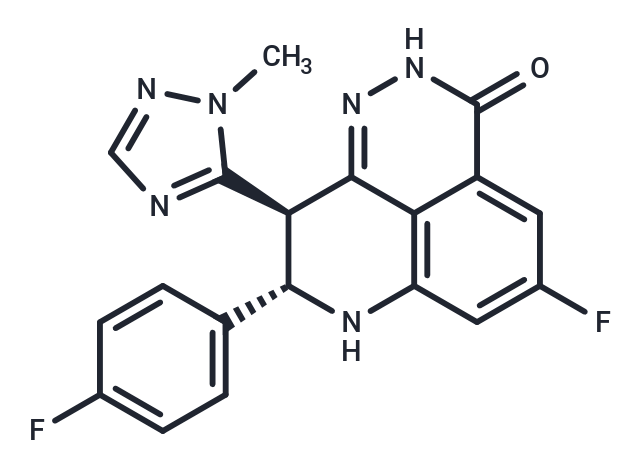 您的购物车当前为空
您的购物车当前为空
Talazoparib
一键复制产品信息别名 他拉唑帕利, LT-673, BMN-673
Talazoparib (LT-673) 是一种 PARP 抑制剂,可以抑制 PARP 1和 PARP 2 (Ki=1.2/0.87 nM),具有口服活性。Talazoparib 具有抗肿瘤活性,可以通过阻断 PARP 酶活性以及将 PARP 捕获在 DNA 损伤位点上来诱导肿瘤细胞死亡。

Talazoparib
一键复制产品信息Talazoparib (LT-673) 是一种 PARP 抑制剂,可以抑制 PARP 1和 PARP 2 (Ki=1.2/0.87 nM),具有口服活性。Talazoparib 具有抗肿瘤活性,可以通过阻断 PARP 酶活性以及将 PARP 捕获在 DNA 损伤位点上来诱导肿瘤细胞死亡。
| 规格 | 价格 | 库存 | 数量 |
|---|---|---|---|
| 1 mg | ¥ 240 | 现货 | |
| 2 mg | ¥ 339 | 现货 | |
| 5 mg | ¥ 559 | 现货 | |
| 10 mg | ¥ 820 | 现货 | |
| 25 mg | ¥ 1,470 | 现货 | |
| 50 mg | ¥ 2,450 | 现货 | |
| 100 mg | ¥ 3,310 | 现货 | |
| 200 mg | ¥ 4,730 | 现货 | |
| 1 mL x 10 mM (in DMSO) | ¥ 623 | 现货 |
Talazoparib 相关产品
产品介绍
| 产品描述 | Talazoparib (LT-673) is a PARP inhibitor that inhibits PARP 1 and PARP 2 (Ki=1.2/0.87 nM) and is orally active. Talazoparib has anti-tumorigenic activity and induces tumor cell death by blocking PARP enzyme activity and by trapping PARP at DNA damage sites. |
| 靶点活性 | PARP2:0.87 nM (Ki, cell free), BT-20 cells:91.6 µM, NCI-H446 cells:EC50 (EC50), PARP1:1.2 nM (Ki, cell free), MDA-MB-468 cells:1 mM, NCI-H146 cells:4.35 nM (EC50) |
| 体外活性 | 方法:12 种 OCCC 细胞系用 Talazoparib (0-100 nM) 处理 14 天,使用 colony formation assays 检测化合物敏感性。 |
| 体内活性 | 方法:为测试体内抗肿瘤活性,将 Talazoparib (0.166-0.33 mg/kg) 口服给药给携带人乳腺癌肿瘤 MX-1 的 athymic nu/nu 小鼠,每天一次或每天两次,持续四周。 |
| 激酶实验 | The ability of a test compound to inhibit PARP1 enzyme activity was assessed using the PARP Assay Kit following the manufacturer's instruction. IC50 values were calculated using GraphPad Prism5 software. For PARP inhibitor Ki determination, enzyme assays were conducted in 96-well FlashPlate with 0.5 U PARP1 enzyme, 0.25× activated DNA, 0.2 μCi [3H] NAD, and 5 μmol/L cold NAD in a final volume of 50 μL reaction buffer containing 10% glycerol (v/v), 25 mmol/L HEPES, 12.5 mmol/L MgCl2, 50 mmol/L KCl, 1 mmol/L dithiothreitol (DTT), and 0.01% NP-40 (v/v), pH 7.6. Reactions were initiated by adding NAD to the PARP reaction mixture with or without inhibitors and incubated for 1 minute at room temperature. Fifty microliter of ice-cold 20% trichloroacetic acid (TCA) was then added to each well to stop the reaction. The plate was sealed and shaken for a further 120 minutes at room temperature, followed by centrifugation. Radioactive signal bound to the FlashPlate was determined using TopCount. PARP1 Km was determined using Michaelis–Menten equation from various substrate concentrations (1–100 μmol/L NAD). Compound Ki was calculated from enzyme inhibition curve according to the formula: Ki = IC50/[1+(substrate)/Km]. Km for PARP2 enzyme and compound Ki were determined with the same assay protocol except 30 ng PARP2, 0.25× activated DNA, 0.2 μCi [3H] NAD, and 20 μmol/L cold NAD were used in the reaction for 30 minutes at room temperature [2]. |
| 细胞实验 | Colony formation assays were conducted as described previously. In brief, cells were seeded into 6-well plates at a concentration of 500 to 2,000 cells per well. After 24 hours, media was replaced with fresh media containing PARP1/2 inhibitor. This procedure was repeated twice weekly for 14 days, at which point colonies were fixed with TCA and stained with sulforhodamine B. Colonies were counted and surviving fractions calculated by normalizing colony counts to colony numbers in vehicle-treated wells. Survival curves were plotted using a four-parameter logistic regression curve fit [2]. |
| 动物实验 | Female athymic nu/nu mice (8–10-week old) were used for all in vivo xenograft studies. Mice were quarantined for at least 1 week before experimental manipulation. Exponentially growing cells (LNcap and MDA-MB-468) or in vivo passaged tumor fragments (MX-1) were implanted subcutaneously at the right flank of nude mice. When tumors reached an average volume of approximately 150 mm^3, mice were randomized into various treatment groups (6–8 mice/group) in each study. Mice were visually observed daily and tumors were measured twice weekly by calliper to determine tumor volume using the formula [length/2] × [width^2]. Group median tumor volume (mm^3) was graphed over time to monitor tumor growth. In single-agent studies, olaparib (100 mg/kg), BMN 673 (various doses as indicated), or vehicle (10% DMAc, 6% Solutol, and 84% PBS) was administered by oral gavage (per os), once daily or BMN 673 (0.165 mg/kg) twice daily for 28 consecutive days. Mice were continuously monitored for 10 more days after last day of dosing. In cisplatin combination study, BMN 673, olaparib, or vehicle was administered per os once daily for 8 days starting on day 1. Cisplatin at a dosage of 6 mg/kg or its vehicle (saline) was administered intraperitoneally as a single injection on day 3, 30 minutes after PARP inhibitor was administered. Combination with carboplatin was conducted in a similar way in MX-1 model in which BMN 673 was administered per os once daily for either 8 days or 5 days and carboplatin was injected intraperitoneally at single dose of 35 mg/kg, 30 minutes after BMN 673 on day 3 [2]. |
| 别名 | 他拉唑帕利, LT-673, BMN-673 |
| 分子量 | 380.35 |
| 分子式 | C19H14F2N6O |
| CAS No. | 1207456-01-6 |
| Smiles | Cn1ncnc1[C@@H]1[C@H](Nc2cc(F)cc3c2c1n[nH]c3=O)c1ccc(F)cc1 |
| 密度 | 1.63 g/cm3 |
| 颜色 | White |
| 物理性状 | Solid |
| 存储 | keep away from moisture,store at low temperature | Powder: -20°C for 3 years | In solvent: -80°C for 1 year | Shipping with blue ice/Shipping at ambient temperature. | ||||||||||||||||||||||||||||||
| 溶解度信息 | DMSO: 36 mg/mL (94.65 mM), Sonication is recommended. H2O: < 1 mg/mL (insoluble or slightly soluble) Ethanol: < 1 mg/mL (insoluble or slightly soluble) | ||||||||||||||||||||||||||||||
| 体内实验配方 | 10% DMSO+90% Saline: 0.1 mg/mL (0.26 mM), Solution. 请按顺序添加溶剂,在添加下一种溶剂之前,尽可能使溶液澄清。如有必要,可通过加热、超声、涡旋处理进行溶解。工作液建议现配现用。以上配方仅供参考,体内配方并不是绝对的,请根据不同情况进行调整。 | ||||||||||||||||||||||||||||||
溶液配制表 | |||||||||||||||||||||||||||||||
DMSO
| |||||||||||||||||||||||||||||||
化合物与蛋白结合的复合物

Structure of the catalytic domain of tankyrase 1 in complex with talazoparib




 很棒
很棒

 |
|
评论内容